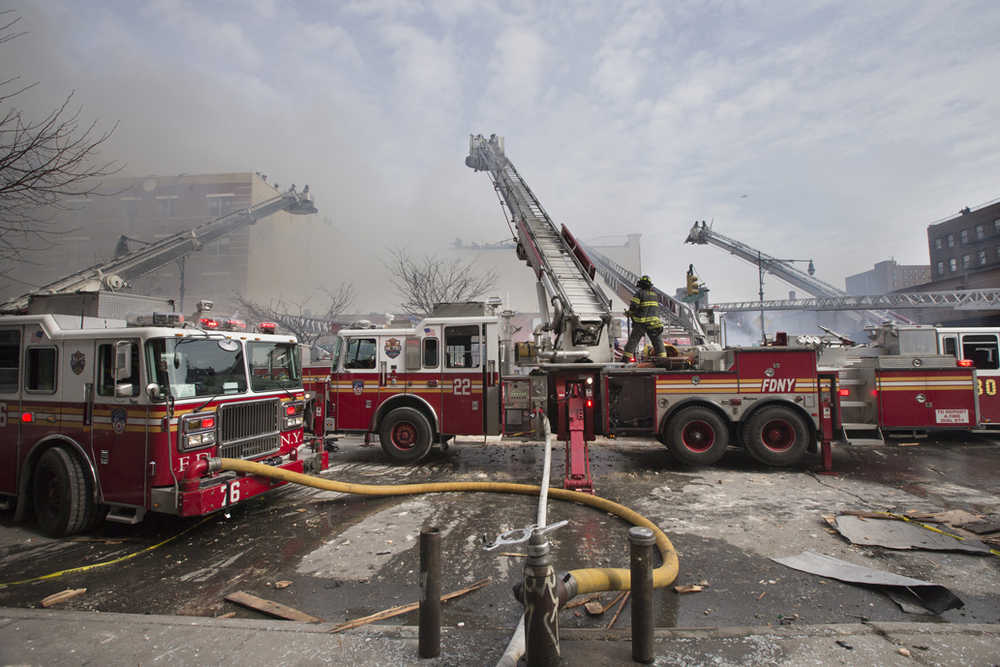NEW YORK — There were times by the end of his shift that firefighter Joseph Nardone’s head would be pounding, his eyes crossing from the noise of the siren on his truck.
“The siren was so loud inside the cab that it actually physically hurt,” said the former New York City fire battalion chief. Even though he’s been retired for over a decade, he said, the effects of the sirens linger in hearing loss that has left him unable to understand rapid conversation or follow along in church.
Nardone is among about 4,400 current and former firefighters nationwide who are suing Federal Signal Corp., an Oak Brook, Illinois-based company that makes sirens, claiming it didn’t do enough to make them safer for those on fire trucks who have to listen to them nearly every day.
They say the company could have designed them in a way that directs the volume away from areas where firefighters sit in the engines, shielding them from sound blasts that lawyers say reach 120 decibels, roughly equivalent to a rock concert. Said the 73-year-old Nardone: “The manufacturer had the means and ability to do something about it and they didn’t.”
Federal Signal argues that directing the sound defeats one of the main purposes of a siren — to warn motorists and pedestrians that a truck is coming. And it says it has long supported what many departments have advised its firefighters to do: wear ear protection.
The lawsuits, which began surfacing more than a decade ago, have been in places such as New York, Philadelphia, Boston, New Jersey and the Chicago area, said attorney Marc Bern, who’s leading all the lawsuits. In documents filed with the Securities and Exchange Commission, the company said juries have decided in favor of Federal Signal in most of the half-dozen or so suits that have gone to trial.
The company also has settled in some cases without admitting any wrongdoing. The largest settlement, reached in 2011, required the company to pay $3.6 million to 1,069 firefighters for cases filed in Philadelphia.
Bern said Federal Signal could have made the sirens with a shroud to warn those in its path instead of a more generalized blare.
“Clearly, you don’t have to have sound going all the way to the rear of the fire engine,” he said.
“If you’re driving behind a fire engine and you don’t see a 50-foot-long, red … engine with lights going on and off, there’s really something wrong.”
David Duffy, attorney for Federal Signal, said making the sirens more directed would put firefighters and the public at greater risk.
“Firefighters have testified that they want a loud siren that projects noise to the front and sides of fire trucks,” he said. Accidents often involve vehicles that hit fire trucks from behind, necessitating a loud noise in all directions, he said.
Duffy also noted that firefighting organizations have for three decades advocated use of earplugs or ear coverings to reduce the risk of hearing loss from sirens or other noises in the course of their firefighting duties, “of which there are many.”
The Fire Department of New York wasn’t able to immediately provide information on its policies on noise or whether earplugs or coverings are provided or required.
Duffy said studies measuring the level of noise firefighters are exposed to during their work shifts, including sirens, is on average below 85 decibels.
Federal standards take into account the intensity of the sound and the duration. The higher the decibel level, the shorter the time workers can be exposed to it.
Rick Neitzel, who studies noise and other exposures at the University of Michigan School of Public Health, said the standards are geared to traditional jobs like manufacturing, not firefighting, where shifts can last for longer and the exposure is intermittent but intense.
“A lot of the questions now are: Is the current recommended level appropriate for exposure that a firefighter would have? And I would say we’re not entirely sure,” he said.
Dr. Lawrence Lustig, a hearing loss expert at Columbia University Medical Center, said people have different levels of susceptibility. Some research involving animals seems to imply that noise exposure in early years leads to more rapid age-related hearing loss, he said.
Retired Bronx firefighter Frank Bazzicalupo was exposed early. He joined the FDNY in his 20s and stayed for 25 years. The 61-year-old spent the last decade or so of that career driving fire trucks before retiring in 2002, hearing the sirens blaring overhead.
These days, trying to hear in any environment that has background noise is an exercise in frustration.
“On a plane is the worst,” he said. “I hear the engines roaring; I can’t hear the person next to me.”
___
Follow Deepti Hajela at twitter.com/dhajela. Her work can be found at http://bigstory.ap.org/content/deepti-hajela

